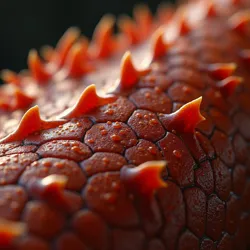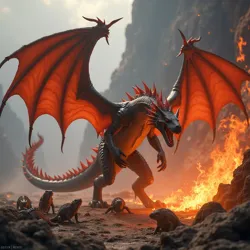Ignis Dragons

Ignis Dragons, apex predators of Dracona's volcanic regions, known for their fiery appearance and elemental abilities.
Dracona
volcanic biomes
Pyros Drakes
15-25 meters
15-30 metric tons
100-200 years
Ignis Dragons, also referred to as Pyros Drakes by some xenobiologists, are a species of elemental dragon native to the volcanic biomes of the planet Dracona. They are the apex predators of the Ignis Fields and Ignis Peaks, regions characterized by extreme heat, volcanic activity, and molten landscapes. Ignis Dragons are renowned for their striking appearance, potent elemental abilities, and crucial role in maintaining the delicate, albeit fiery, ecosystems they inhabit. As integral components of Dracona's unique biosphere, Ignis Dragons have become subjects of intense interest for xenobiologists, particularly the Explorers of the Obsidian Eye, who are currently studying Dracona and its extraordinary inhabitants.
Evolutionary Origins and Phylogeny
The evolutionary history of Ignis Dragons, like that of all elemental dragons on Dracona, is a subject of ongoing scientific inquiry. Current phylogenetic analyses, based on comparative anatomy, elemental energy signatures, and preliminary genetic sequencing, suggest that Ignis Dragons share a common ancestor with other Draconian dragon species, diverging millions of years ago to specialize in the fire-dominated biomes of the planet. This divergence is believed to have been driven by intense selective pressures within the nascent volcanic regions of Dracona, favoring adaptations that conferred advantages in high-temperature environments, volcanic terrains, and diets based on heat-resistant organisms.
One prevailing hypothesis posits that the ancestral Draconian dragons were more generalized, possessing a broader range of elemental affinities and inhabiting a more diverse set of environments. As Dracona's elemental biomes differentiated and intensified, these ancestral dragons diversified into distinct lineages, each specializing in one of the four primary elements: fire, water, earth, and air. Ignis Dragons represent the culmination of the fire-specialized lineage, exhibiting a suite of remarkable adaptations that allow them to not only survive but thrive in conditions that would be lethal to most other known lifeforms.
Fossil evidence, though scarce due to the destructive nature of volcanic environments, hints at earlier forms of proto-Ignis Dragons that were less overtly adapted to extreme heat. These transitional fossils suggest a gradual acquisition of key traits, such as heat-radiating scales, internal thermoregulation mechanisms, and the ability to metabolize geothermal energy. The ongoing volcanic activity in the Ignis Fields constantly reshapes the landscape and often destroys potential fossil sites, making the paleontological record of Ignis Dragons incomplete and challenging to interpret.
Physical Characteristics
Ignis Dragons are imposing creatures, characterized by a robust and heavily armored physique, perfectly suited for their volcanic habitat. Adult Ignis Dragons typically range in length from 15 to 25 meters, with some exceptional individuals reaching lengths of up to 30 meters. Their weight can vary considerably depending on age and individual size, but mature specimens often weigh between 15 to 30 metric tons.
Integument and Scales
The most distinctive feature of Ignis Dragons is their integument, composed of thick, overlapping scales that exhibit a remarkable range of adaptations. These scales are not merely protective armor but are integral to their thermoregulation and elemental interaction. The outer layer of the scales is composed of a unique bio-ceramic material, infused with metallic elements that give them a characteristic sheen, ranging from deep obsidian to fiery crimson and molten gold, depending on the dragon's age and health. These scales are incredibly heat-resistant, capable of withstanding temperatures exceeding 1,200 degrees Celsius without significant degradation.
Beneath the outer bio-ceramic layer, the scales contain a complex network of micro-channels filled with a specialized fluid that circulates throughout the dragon's body. This fluid acts as a highly efficient heat exchanger, dissipating excess thermal energy into the environment, giving Ignis Dragons their signature heat aura. The scales also possess bioluminescent properties, emitting a soft, internal glow, particularly noticeable in low-light conditions within volcanic caves or during nocturnal activity. This bioluminescence is believed to play a role in intraspecies communication and display, intensifying during mating rituals and territorial disputes.
Skeletal and Muscular Systems
Ignis Dragons possess a dense and robust skeletal structure, composed of ossified bone reinforced with metallic trace elements, contributing to their immense weight and resilience. Their bone marrow is uniquely adapted to withstand high temperatures, producing heat-resistant blood cells and maintaining hematopoietic function even under extreme thermal stress. The muscular system is powerfully developed, allowing for impressive feats of strength and agility, despite their bulk. Ignis Dragons are capable of rapid bursts of speed, both on land and in short flights, and their powerful limbs and claws are well-suited for navigating rugged volcanic terrain and manipulating molten rock.
Their wings, while proportionally smaller compared to Ventus Dragons, are still functional and allow for limited aerial locomotion. Ignis Dragons primarily use their wings for gliding across lava flows, maneuvering through volcanic canyons, and intimidating displays. Flight for prolonged distances is energetically costly for Ignis Dragons, and they generally prefer terrestrial movement within their territories.
Internal Organs and Physiology
The internal organs of Ignis Dragons exhibit a suite of extraordinary adaptations to the extreme thermal environment. Their respiratory system is highly efficient at extracting oxygen from the volcanic gas-rich atmosphere of the Ignis Fields, and their lungs are lined with heat-resistant tissues that prevent thermal damage from inhaled superheated air. Their circulatory system is uniquely designed to manage extreme temperature gradients within their bodies, with specialized vascular structures that dissipate heat from core organs and distribute it to the heat-radiating scales.
Ignis Dragons possess a multi-chambered heart that pumps highly oxygenated, metallic-rich blood throughout their body. Their blood contains unique proteins and enzymes that remain functional at high temperatures, preventing denaturation and maintaining physiological processes under extreme conditions. Their digestive system is adapted to process a diet of heat-resistant organisms and, in some cases, to extract energy from geothermal sources. Specialized organs within their digestive tract can break down and assimilate minerals and geothermal compounds, supplementing their metabolic needs in the resource-scarce volcanic environment.
Perhaps the most remarkable physiological adaptation of Ignis Dragons is their capacity for elemental energy manipulation. They possess specialized organs, located near their throat and within their chest cavity, that can generate and project intense bursts of fire and molten rock. These organs, often referred to as "pyro-sacs," are lined with heat-resistant tissues and contain a volatile mixture of bio-chemical compounds that, when ignited, produce superheated flames and molten projectiles. The exact mechanisms of pyro-sac function are still under investigation, but it is believed to involve a complex interplay of chemical reactions, bio-electrical stimulation, and potentially, a form of controlled elemental energy transduction.
Habitat and Distribution
Ignis Dragons are exclusively found within the Ignis Fields and Ignis Peaks regions of Dracona, the planet's primary volcanic biomes. These areas are characterized by intense geothermal activity, active volcanoes, vast lava flows, obsidian plains, and geothermal vent fields. The atmosphere in these regions is dense with volcanic gases, and the ground surface temperatures can reach hundreds of degrees Celsius.
 An Ignis Dragon in its natural habitat within the volcanic landscape of the Ignis Fields on planet Dracona.
An Ignis Dragon in its natural habitat within the volcanic landscape of the Ignis Fields on planet Dracona.Ignis Fields
The Ignis Fields constitute the vast equatorial volcanic plains of Dracona, a sprawling expanse of molten landscapes, active volcanoes, and geothermal features. This biome is a dynamic and constantly changing environment, shaped by ongoing volcanic eruptions, lava flows, and tectonic shifts. Ignis Dragons are the dominant apex predators of the Ignis Fields, carving out territories within specific volcanic zones, often centered around active volcanoes or geothermal hotspots. They are adept at navigating the treacherous terrain, utilizing lava tubes, obsidian caves, and geothermal vents for shelter and nesting sites.
Ignis Peaks
The Ignis Peaks are towering volcanic mountain ranges that punctuate the Ignis Fields, representing zones of intense geological uplift and volcanic activity. These mountains are characterized by steep slopes, volcanic craters, fumaroles, and pyroclastic flows. Ignis Dragons also inhabit the higher altitudes of the Ignis Peaks, establishing aeries within volcanic calderas or on cliff faces overlooking lava valleys. The thinner atmosphere and colder temperatures at higher elevations pose some challenges, but Ignis Dragons are capable of adapting to these variations, often utilizing geothermal vents at higher altitudes for warmth and energy.
Distribution Patterns
Ignis Dragon distribution within the Ignis Fields and Ignis Peaks is not uniform but rather clustered around areas of high geothermal activity and prey availability. They exhibit territorial behavior, with individual dragons or mated pairs controlling specific volcanic zones, often marked by prominent geological features or geothermal hotspots. Population densities vary depending on the local volcanic activity and resource availability, with higher densities typically found in regions with active volcanoes and abundant geothermal vents.
Ignis Dragons are largely confined to the Ignis biomes due to their specialized adaptations and dependence on high-temperature environments. While they are capable of venturing into adjacent biomes, such as the transitional zones bordering the Terran Spires, they are not well-suited for prolonged survival outside of their fire-dominated habitats. Ecotones between the Ignis Fields and other biomes are typically inhabited by less specialized dragon species or hybrid forms, if they manage to survive.
Behavior and Ecology
Ignis Dragons are formidable and complex creatures, exhibiting a range of behaviors adapted to their challenging environment and their role as apex predators. Their behavior is driven by the need to survive in a resource-scarce, high-temperature environment, defend territories, and reproduce successfully.
 Close-up of Ignis Dragon scales, showcasing their bio-ceramic composition and heat-radiating properties.
Close-up of Ignis Dragon scales, showcasing their bio-ceramic composition and heat-radiating properties.Diet and Hunting Strategies
Ignis Dragons are primarily carnivores, feeding on a variety of heat-resistant fauna that inhabit the Ignis Fields. Their diet consists of pyro-reptiles, magma-worms, geothermal crustaceans, and other specialized organisms adapted to extreme thermal conditions. They are opportunistic hunters, utilizing a combination of ambush tactics, pursuit predation, and scavenging.
Ignis Dragons are known to employ several hunting strategies, depending on the prey type and environmental conditions. They may lie in ambush near geothermal vents or lava flows, using their heat camouflage to blend into the background and surprise unsuspecting prey. They are also capable of pursuit predation, using bursts of speed and agility to chase down fleeing prey across obsidian plains or through volcanic canyons. In addition to live prey, Ignis Dragons will also scavenge carcasses of deceased animals, utilizing their powerful jaws and digestive system to consume even partially incinerated remains.
One unique aspect of Ignis Dragon ecology is their ability to supplement their diet by directly absorbing geothermal energy. They possess specialized organs on their ventral scales, known as "thermo-receptors," that can absorb thermal radiation from geothermal vents and lava flows. This geothermal energy is converted into metabolic energy, providing a supplementary energy source, particularly during periods of prey scarcity or high energy expenditure.
Social Structure and Territoriality
Ignis Dragons are generally solitary and territorial creatures, particularly outside of the mating season. They establish and defend individual territories, often marked by prominent volcanic features, geothermal hotspots, or scent markings. Territorial boundaries are fiercely defended against intruding dragons of the same species, particularly males competing for resources or mating opportunities.
Territorial disputes between Ignis Dragons can be dramatic and intense, involving roaring displays, fire breath attacks, wing buffeting, and physical confrontations. Battles are typically resolved through displays of dominance and intimidation, with actual physical combat being relatively rare, as injuries in the harsh volcanic environment can be detrimental to survival.
During the mating season, territoriality may become temporarily relaxed as males and females seek out mates. Mating rituals involve elaborate displays of fire breath, bioluminescence, and aerial maneuvers. Once a pair bond is formed, they may temporarily share a territory for nesting and raising offspring, but the pair bond is typically short-lived, and adults revert to solitary territoriality after the offspring reach independence.
Lifecycle and Reproduction
Ignis Dragons have a relatively rapid lifecycle compared to some other Draconian dragon species, reflecting the volatile and unpredictable nature of their volcanic habitat. They reach sexual maturity at around 20 to 30 years of age and have a lifespan of approximately 100 to 200 years, although some exceptional individuals may live longer.
Reproduction in Ignis Dragons is oviparous, with females laying clutches of heat-resistant eggs. Nesting sites are carefully selected within geothermal vents, lava tubes, or volcanic fissures, providing natural incubation temperatures for the eggs. Clutch sizes typically range from 2 to 5 eggs, and the incubation period lasts for several months, depending on the geothermal conditions.
Ignis Dragon eggs are remarkable for their heat resistance, possessing thick, mineralized shells that protect the developing embryos from extreme temperatures and volcanic gases. Parental care is minimal, with females sometimes guarding the nest site for a short period after laying eggs, but once hatched, the dragon hatchlings are precocial and largely independent, immediately adapted to survive in the volcanic environment.
Elemental Interactions and Ecosystem Role
Ignis Dragons are not merely inhabitants of the Ignis Fields; they are integral components of the biome's ecosystem, playing a crucial role in shaping and maintaining its unique characteristics. Their interactions with elemental fire and volcanic processes are multifaceted and essential for the ecological balance of the Ignis Fields.
Their burrowing activities, territorial movements, and feeding habits influence lava flows, geothermal vent patterns, and the distribution of volcanic materials. By regulating prey populations and consuming heat-resistant organisms, they control the flow of energy and nutrients within the food web. Their shed scales and excrement contribute to the mineral composition of the volcanic soil, influencing the growth of heat-resistant flora, such as thermophilic fungi and bacteria, which form the base of the food chain.
Ignis Dragons also play a role in regulating volcanic activity. Their movements and burrowing habits can help to vent pressure buildup within volcanic systems, preventing excessively explosive eruptions. Conversely, their presence can also concentrate geothermal energy in specific zones, creating hotspots of volcanic activity and influencing the overall thermal dynamics of the Ignis Fields. Their existence is thus intrinsically linked to the fiery nature of their environment, acting as both a product and a shaper of the volcanic biome.
Relationship with Other Draconian Lifeforms
While Ignis Dragons are primarily adapted to and confined within the Ignis Fields and Ignis Peaks, they do interact with other Draconian dragon species and lifeforms, particularly in the ecotones bordering their biome. These interactions can range from territorial disputes to predator-prey relationships and occasional interspecies competition for resources.
 An Ignis Dragon hunting pyro-reptiles in a geothermal vent field, showcasing its hunting prowess.
An Ignis Dragon hunting pyro-reptiles in a geothermal vent field, showcasing its hunting prowess.Interactions with Other Elemental Dragons
Interactions between Ignis Dragons and other elemental dragon types, such as Aquamarina Dragons, Terran Dragons, and Ventus Dragons, are relatively infrequent and often territorial in nature. Ecotones between biomes, such as the volcanic foothills transitioning into rocky highlands, can be zones of overlap and potential conflict.
Ignis Dragons are generally dominant over Terran Dragons in territorial disputes within these transitional zones, due to their greater size and elemental firepower. However, Terran Dragons, with their armored hides and earth manipulation abilities, can pose a formidable defense in their own earth-dominated territories. Interactions with Aquamarina Dragons and Ventus Dragons are even less frequent, as their primary habitats are geographically separated from the Ignis Fields. Encounters might occur in coastal volcanic regions or during rare instances of Ventus Dragons migrating over volcanic peaks, but these are typically brief and non-confrontational.
Predator-Prey and Competitive Relationships
Ignis Dragons are apex predators within their biome, with no natural predators among Draconian lifeforms. However, they may occasionally compete with other large carnivores, such as pyro-raptors or magma-hounds, for prey resources within the Ignis Fields. They are also known to prey on smaller, less specialized dragon species that venture into their territories from adjacent biomes.
Conversely, juvenile or weakened Ignis Dragons may be vulnerable to predation by larger, more opportunistic carnivores if they stray too far from the protection of their core territories. Competition for nesting sites, geothermal vents, and prey resources can occur between Ignis Dragons and other heat-adapted species, but their dominant position in the food web generally ensures their access to prime resources within their biome.
Symbiotic and Commensal Relationships
While not extensively documented, Ignis Dragons may engage in some forms of symbiotic or commensal relationships with other Draconian lifeforms. Smaller, heat-resistant organisms may benefit from the heat and shelter provided by Ignis Dragon territories, establishing commensal relationships within lava tubes or geothermal vent systems controlled by the dragons.
Certain types of thermophilic fungi or bacteria may form symbiotic associations with Ignis Dragons, aiding in digestion or providing other beneficial functions. Further research is needed to fully understand the extent and nature of these interspecies relationships within the complex ecosystems of the Ignis Fields.
Cultural Significance and Xenobiological Study
Ignis Dragons, as the dominant and most visually striking inhabitants of Dracona's volcanic biomes, hold a significant place in the xenobiological understanding of the planet and its unique ecosystems. Their awe-inspiring power, elemental adaptations, and crucial ecological role have made them a focal point of scientific interest and ethical consideration, particularly for the Explorers of the Obsidian Eye.
Xenobiological Fascination
The Explorers of the Obsidian Eye, upon their discovery of Dracona, were immediately captivated by the elemental dragons and their remarkable adaptations to extreme environments. Ignis Dragons, in particular, drew intense scientific attention due to their mastery of fire and their ability to thrive in conditions considered inhospitable to most known lifeforms.
Xenobiologists on board the Umbral Voyager have dedicated significant resources to studying Ignis Dragons through non-invasive observation, remote sensing, and unmanned probes. They have documented their physiology, behavior, ecology, and elemental interactions, seeking to understand the evolutionary mechanisms and biological principles that underpin their extraordinary adaptations. Ignis Dragons serve as a prime example of convergent evolution, showcasing how life can adapt to extreme conditions and carve out ecological niches in seemingly hostile environments.
Ethical Considerations
The study of Ignis Dragons by the Explorers of the Obsidian Eye is guided by a strong ethical framework, prioritizing non-interference and minimizing any potential impact on the dragons and their ecosystems. Observation protocols are designed to be as unobtrusive as possible, utilizing remote sensing technologies and autonomous probes to gather data without directly disturbing dragon populations.
Ethical guidelines prohibit any form of direct manipulation, capture, or invasive experimentation on Ignis Dragons. The explorers recognize the intrinsic value of these magnificent creatures and their crucial role in maintaining the ecological balance of Dracona. Their research is focused on understanding and appreciating the dragons in their natural context, promoting conservation and respect for Dracona's unique biosphere.
Potential for Future Research
Ongoing research on Ignis Dragons promises to yield further insights into the principles of elemental adaptation, extreme environment biology, and the evolution of complex lifeforms in diverse planetary conditions. Future research may focus on deciphering the intricate mechanisms of pyro-sac function, understanding the genetic basis of their heat resistance, and exploring the complex communication signals they employ within their social structures.
Advanced non-invasive technologies, such as bio-acoustic monitoring, thermal imaging, and atmospheric sampling, may provide even more detailed data on Ignis Dragon behavior and ecology without requiring direct physical contact. Xenolinguists are working to decode potential communication patterns in their vocalizations and bioluminescent displays, seeking to gain a deeper understanding of their cognitive abilities and social interactions. The Ignis Dragons of Dracona represent a treasure trove of scientific knowledge, offering profound insights into the diversity and adaptability of life in the cosmos.
Conservation Status and Future Prospects
Currently, Ignis Dragon populations on Dracona are considered stable within their native biomes. The vastness of the Ignis Fields and Ignis Peaks, combined with their apex predator status and natural defenses, ensures that they are not facing immediate threats from within their ecosystem. However, long-term conservation prospects require ongoing monitoring and careful consideration, particularly in light of potential external factors and the ethical responsibilities of extraterrestrial contact.
Potential Threats
While no natural predators currently threaten adult Ignis Dragons, potential long-term threats could arise from environmental changes, resource depletion, or unforeseen disruptions to their volcanic habitat. Significant shifts in Dracona's volcanic activity, whether due to planetary geological processes or external influences, could impact the availability of geothermal energy, prey populations, and suitable nesting sites.
The introduction of invasive species, either inadvertently or intentionally, could also pose a threat to Ignis Dragon populations, potentially competing for resources or disrupting the delicate ecological balance of the Ignis Fields. While the Explorers of the Obsidian Eye are committed to non-interference, future interactions with other interstellar civilizations or unforeseen events could introduce new challenges to the conservation of Dracona's unique biosphere.
Conservation Efforts and Monitoring
The Explorers of the Obsidian Eye, as the primary observers of Dracona, are committed to ongoing monitoring of Ignis Dragon populations and the overall health of the Ignis Fields ecosystem. Unmanned probes and orbital sensors provide continuous data on dragon population trends, volcanic activity levels, and environmental conditions within their habitats.
Ethical protocols emphasize minimal impact research and non-interference, ensuring that scientific studies do not disrupt dragon behavior or ecosystems. Future conservation efforts may involve establishing protected zones within the Ignis Fields, safeguarding critical nesting sites and geothermal hotspots, and implementing early warning systems to detect potential threats to dragon populations.
Future Coexistence
The long-term future of Ignis Dragons, like that of all Draconian lifeforms, is intertwined with the ethical considerations of extraterrestrial contact and the potential for future interactions with interstellar civilizations. The Explorers of the Obsidian Eye advocate for a cautious and respectful approach, prioritizing non-interference and promoting peaceful coexistence.
Understanding and appreciating the unique value of Ignis Dragons and their role in Dracona's biosphere is crucial for ensuring their continued survival and thriving existence. As humanity and other interstellar civilizations expand their knowledge of the cosmos, the ethical imperative to protect and conserve the diversity of life, including magnificent creatures like Ignis Dragons, must remain paramount.